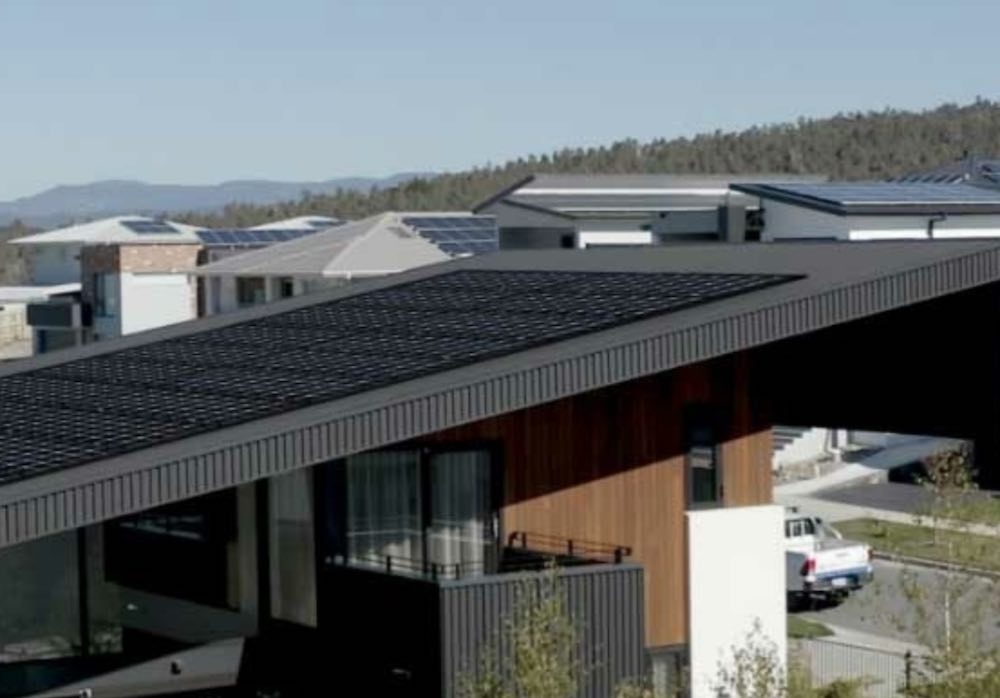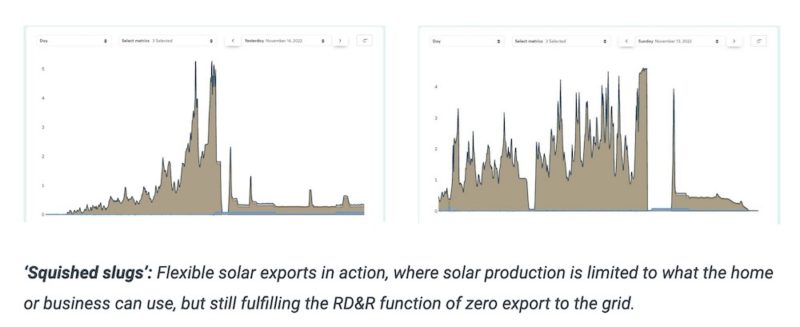
The weekend before last, a storm knocked down a transmission tower in South Australia, severing one of South Australia’s connections to Victoria and (nearly*) islanding the state from the rest of the National Electricity Market (NEM).
Rare islanding events like this are not themselves necessarily a problem, and are not the current cause of the power losses affecting tens of thousands of people in the state; these outages are localised, and are attributable to fallen trees and electrical poles. However, it does mean that AEMO has fewer tools at its disposal to maintain grid stability.
That’s why AEMO and distribution network operator SA Power Networks are pulling out the stops to make sure the lights stay on, including the Remote Disconnection and Reconnection (RD&R) emergency backstop for rooftop solar (aka ‘the Big Solar Button’ as Dr Nick Engerer of Solcast dubbed it).
The fact that the Big Solar Button has been pushed is something that has grabbed a bit of attention in industry media like WattClarity and RenewEconomy, and SA Power Networks even put out a call to customers over Facebook to shut off their rooftop solar systems manually.
It’s understandable that these events are being highlighted – the tools being deployed are relatively new and still noteworthy. They have been put in place to provide some interim measures to assist in managing solar exports while South Australia waits for the completion and energisation of a second interconnector – with NSW.
This new interconnector will provide significant backup contingency for AEMO in managing these events in the future. (Until this large infrastructure project is completed – potentially 2026 – the measures are in place and available to manage minimum demand events and situations such as when the state is islanded.)
A snapshot of the state of rooftop solar management
At SwitchDin, we see a future where smart management of distributed energy resources (DER) like solar is just a part of the way things work on our grid – but right now we’re only part way there.
Looking at what’s happening in SA during and around this incident gives us a feel for the current state of distributed rooftop solar management ‘in the wild’ – and it’s much more interesting that it would first appear.
SwitchDin is supporting all of these solutions with a full toolkit for energy companies. Below we’ll take a look at the tools being deployed and how they support clean, distributed energy systems by:
-
Making it possible for distributed energy assets to play an active, integrated role in how the grid works
-
Enabling smart management of fleets of assets – even with mixed brands and types of equipment
-
Delivering value for end users by allowing them to be participants and beneficiaries in this ‘brave new grid’, where they can use their solar & other assets for themselves (like self-consumption) while also providing services into the grid
-
Allowing for rapid scaling of DER management in the grid’s operation for sites small and large
Let’s look at what’s happening.
The Big Solar Button is working as planned, but was always meant to be an emergency backstop
The RD&R function is an emergency backstop introduced to solve the urgent problem of managing huge amounts of distributed solar on the SA grid. On the scale of fair and balanced solutions for management of rooftop solar, it sits a notch above ‘zero export limits’ and is a notch below the more sophisticated Flexible – or ‘Dynamic’ – Exports approach, for which SwitchDin is a key enabler (more below).
In terms of its function during this islanding event, SA Power Networks has confirmed RD&R did what it was supposed to: It allowed them (at AEMO’S request) to shut down large amounts of rooftop solar to help retain the predictability in the grid’s operation through a turbulent moment – and keep the lights on for as many people as possible.
For system owners, having your solar switched off in an electricity system emergency is a relatively small sacrifice in the name of keeping the power on, which is after all the main prerogative of the network operator to the benefit of everyone connected to the grid. But it falls short of our collective vision of a world / grid in which rooftop solar and other types of distributed assets are a living, breathing part of how people get their electricity.
The old-school alternative to this approach would have been rolling blackouts across different network substation zones. Instead, the only outages that did occur were due to distribution network lines or other infrastructure getting physically knocked around. (Nice work, SA Power Networks!)
Here’s what RD&R looks like for an individual site. In theory, all homes and businesses who are RD&R capable could still produce solar energy for self-use (‘self-consumption’) but in reality very few systems actually do this – hence the 100% clipped solar production in the middle of the day that you can see below.
Flexible export is already doing the same thing as RD&R – but better
RD&R is a relatively clunky, interim measure that was meant to fill a gap until something better came along. That ‘something better’ is Flexible / Dynamic Exports, and it can handle the RD&R function, but with enough intelligence to do much more.
SA Power Networks has been leading the way in developing dynamic orchestration of solar capacity via a new option called Flexible Exports. SA Power Networks and SwitchDin are currently involved in a trial of the technology, which is showing very positive results.
The SA Government’s Dynamic Export mandate is coming into place for the whole state for new solar systems from July next year, but SwitchDin is already rolling out this functionality for SA Power Networks through flexible exports in key locations with high penetrations of rooftop solar.
(For clarity, ‘Dynamic Exports’ requirements is a new regulation requiring most new inverter systems installed in SA to be ‘dynamically exports capable’. ‘Flexible Exports’ is a connection option offered by SA Power Networks in conjunction with the new requirements. SA Power Networks has been trialling Flexible Exports in key suburbs.)
As the name suggests, flexible export gives much more flexibility to how the solar systems operate – rather than serving as an off/on switch, it allows export limits to vary throughout the day because the network operator can communicate with the systems.
For most of the time, flexible exports will allow customers to export the maximum amount that the network and their inverter can handle – between 1.5kW up to 10kW per phase. But when there’s too much solar for the network to handle, exports will be automatically adjusted to match the network capacity.
It’s a much smarter way to achieve the same goal, and brings more benefit to the solar system owners because they can keep generating solar energy in a way that’s safe – and even useful – for the grid because the network operator knows what they’re doing.
As illustrated in the screenshot below, flexible exports sites are fulfilling the function of RD&R but preserving self-consumption for customers, meaning that even with the grid in ‘solar shutdown’ mode, system owners still get to benefit from their solar – they just can’t export any energy back to the grid (goodbye, feed-in tariff revenue). While not ideal, this is certainly better than ‘zero solar’.
And when the grid is un-islanded, solar export will return to normal for them, thanks to the fact that flexible exports-ready systems can adjust dynamically depending on available network capacity in their area throughout the day.
Just the beginning: Project Symphony as a sneak peek of what’s in store for DER-integrated grids
SA Power Networks’ Distribution Energy Transition Roadmap 2020-25 sets out a whole tranche of changes that bring its grid closer to DER integration paradise. One of the next steps is the expansion of Flexible Exports connection option for solar across SA (as noted above), and a more nuanced and sophisticated approach to Flexible Exports thereafter, including sites with multiple devices (starting with multiple inverters, hybrid inverters and battery storage and moving on to EV chargers and other key loads).
SwitchDin is rolling out these types of capabilities already in Western Australia with Project Symphony, which provides a window into what’s in store for SA in the not-so-distant future.
In practice, this means:
-
Solar, batteries and (soon) heat pump hot water systems being coordinated at the site-level to work within dynamic operating envelopes (DOEs) similar to Dynamic / Flexible Exports,
-
These sites providing not just solar curtailment, but also network services into the grid to boost stability and efficiency of the energy system; and
-
Coordination of fleets of sites as part of everyday grid operations in concert with ‘front of meter’ assets like battery storage and solar farms.
All eyes on SA for the energy transition
Given the absence of coal generators operating in the state and a country-leading percentage of renewable energy generation, the SA grid is in many ways showing the world what the energy transition means for gigawatt-scale energy systems.
Even more crucially for distributed energy space, the state leads the country – and much of the world – in rooftop solar adoption, and has recently hit multiple new records in terms of the proportion of its energy needs met by behind-the-meter solar. This includes days where rooftop solar can meet 100% of energy demand – or even drive demand negative.
It’s notable that during the current challenges for the SA grid, gas generation is providing flexibility for the SA grid to make up for what was lost when the interconnector went down.
Heading towards net zero grids, we need to achieve this flexibility with other assets; this requires fast scaling of visibility and control for both in front of and behind the meter.
We have shown that these tools are already being deployed, and now it’s time to ramp them up.
*SA has two transmission interconnectors with Victoria: Heywood and Murraylink. Heywood is the interconnector that is currently down; it is an AC connection and can provide balancing support for the SA grid. Murraylink is still operating, but is a smaller, DC connection.
James Martin is communications manager for SwitchDin. This a lightly edited version of an article that was originally published on the SwitchDin blog. Republished here with permission. Read the original article here.



